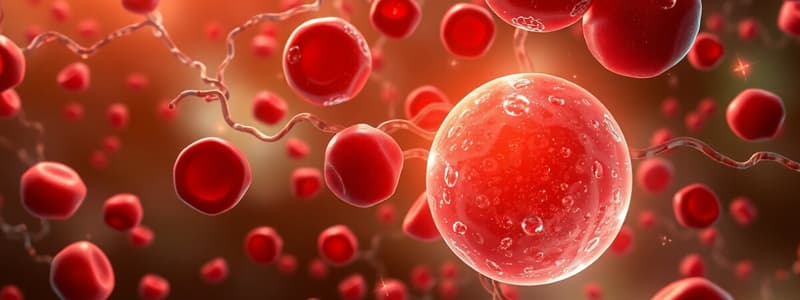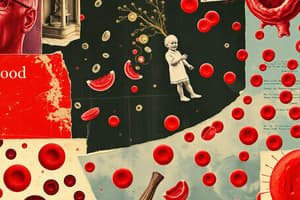Podcast
Questions and Answers
Which of the following is NOT a primary function of blood?
Which of the following is NOT a primary function of blood?
- Protecting the body from infection by transporting white blood cells
- Transporting oxygen from the lungs to the body
- Transporting carbon dioxide from the body to the lungs
- Producing hormones within endocrine glands (correct)
Red blood cells primarily function to defend the body against infection and foreign materials.
Red blood cells primarily function to defend the body against infection and foreign materials.
False (B)
What percentage of blood volume is typically made up of plasma?
What percentage of blood volume is typically made up of plasma?
55%
The iron-containing protein in red blood cells that binds to oxygen is called ______.
The iron-containing protein in red blood cells that binds to oxygen is called ______.
Match the blood component with its primary function:
Match the blood component with its primary function:
Which plasma protein is MOST important for maintaining osmotic pressure in blood vessels?
Which plasma protein is MOST important for maintaining osmotic pressure in blood vessels?
Plasma is composed of approximately 50% water.
Plasma is composed of approximately 50% water.
If a patient has a condition that impairs their ability to form blood clots, which component of the blood is most likely affected?
If a patient has a condition that impairs their ability to form blood clots, which component of the blood is most likely affected?
Which of the following is the primary function of red blood cells?
Which of the following is the primary function of red blood cells?
Platelets, unlike red and white blood cells, contain a nucleus.
Platelets, unlike red and white blood cells, contain a nucleus.
What protein, found in red blood cells, binds to oxygen?
What protein, found in red blood cells, binds to oxygen?
The most abundant type of white blood cell, which is a first responder to infection, is the ________.
The most abundant type of white blood cell, which is a first responder to infection, is the ________.
Match the type of white blood cell with its primary function:
Match the type of white blood cell with its primary function:
Which of the following electrolytes, found in plasma, is crucial for nerve and muscle function?
Which of the following electrolytes, found in plasma, is crucial for nerve and muscle function?
The lifespan of platelets is approximately 120 days, similar to red blood cells.
The lifespan of platelets is approximately 120 days, similar to red blood cells.
What is the name of the process by which neutrophils engulf and destroy bacteria?
What is the name of the process by which neutrophils engulf and destroy bacteria?
The protein that forms a mesh-like network to stabilize a platelet plug is called ________.
The protein that forms a mesh-like network to stabilize a platelet plug is called ________.
Which type of white blood cell is responsible for producing antibodies?
Which type of white blood cell is responsible for producing antibodies?
Flashcards
What is blood?
What is blood?
Specialized fluid delivering nutrients and oxygen to cells, removing waste.
What are blood cells?
What are blood cells?
Red blood cells (erythrocytes), white blood cells (leukocytes) and platelets (thrombocytes).
What is plasma?
What is plasma?
The clear, liquid part of blood, mostly water, carrying dissolved substances.
What are blood's main functions?
What are blood's main functions?
Signup and view all the flashcards
What is blood's main respiratory role?
What is blood's main respiratory role?
Signup and view all the flashcards
What is plasma composed of?
What is plasma composed of?
Signup and view all the flashcards
What is albumin's function?
What is albumin's function?
Signup and view all the flashcards
What do globulins do?
What do globulins do?
Signup and view all the flashcards
Plasma
Plasma
Signup and view all the flashcards
Red Blood Cells (Erythrocytes)
Red Blood Cells (Erythrocytes)
Signup and view all the flashcards
Hemoglobin
Hemoglobin
Signup and view all the flashcards
White Blood Cells (Leukocytes)
White Blood Cells (Leukocytes)
Signup and view all the flashcards
Neutrophils
Neutrophils
Signup and view all the flashcards
Eosinophils
Eosinophils
Signup and view all the flashcards
Basophils
Basophils
Signup and view all the flashcards
Lymphocytes
Lymphocytes
Signup and view all the flashcards
Platelets (Thrombocytes)
Platelets (Thrombocytes)
Signup and view all the flashcards
Coagulation Cascade
Coagulation Cascade
Signup and view all the flashcards
Study Notes
- Blood is a specialized bodily fluid in animals, delivering nutrients and oxygen. Blood delivers nutrients and waste. Blood consists of blood cells suspended in blood plasma.
- Plasma, 55% of blood fluid, is mainly water (92% by volume) and contains dissolved proteins, glucose, mineral ions, hormones, carbon dioxide, and blood cells.
- Blood cells include red blood cells (erythrocytes), white blood cells (leukocytes), and platelets (thrombocytes).
- Red blood cells are the most abundant, delivering oxygen to tissues.
- White blood cells, part of the immune system, defend against infection.
- Platelets are responsible for blood clotting.
- Blood circulates via blood vessels, propelled by the heart's pumping.
- Vertebrate blood is red due to hemoglobin, an iron-containing protein in red blood cells.
Blood Functions
- Transports oxygen from the lungs throughout the body.
- Transports carbon dioxide from the body to the lungs for exhalation.
- Transports nutrients from the digestive tract throughout the body.
- Transports waste from cells to the kidneys for excretion.
- Transports hormones from glands to target tissues.
- Regulates body temperature via heat distribution.
- Maintains fluid balance by regulating water content in cells and tissues.
- Maintains pH balance as a buffer.
- Protects against infection by transporting white blood cells and antibodies.
- Forms clots to prevent excessive blood loss.
Blood Components
Plasma
- Plasma is the clear, straw-colored liquid remaining after removing blood cells, platelets, and other elements.
- It makes up about 55% of total blood volume.
- Plasma is about 92% water, acting as a solvent.
- It contains proteins like albumin, globulins, and fibrinogen.
- Albumin maintains osmotic pressure, preventing fluid leakage from vessels.
- Globulins include antibodies (immunoglobulins) for infection and transport proteins for lipids and hormones.
- Fibrinogen is essential for clotting, converting to fibrin.
- Plasma contains electrolytes like sodium, potassium, calcium, magnesium, chloride, bicarbonate, and phosphate, vital for fluid, nerve, muscle, and pH balance.
- Plasma carries nutrients like glucose, amino acids, fatty acids, and vitamins to cells.
- Plasma carries waste like urea, creatinine, and bilirubin to the kidneys and liver for excretion.
- Plasma transports hormones to target tissues, regulating functions.
- Plasma contains dissolved gases, though red blood cells carry most oxygen.
Red Blood Cells (Erythrocytes)
- Red blood cells (erythrocytes) transport oxygen from the lungs to tissues and carbon dioxide back to the lungs.
- They are produced in bone marrow.
- Mature red blood cells are biconcave discs, increasing surface area for gas exchange and allowing passage through capillaries.
- Red blood cells are flexible, deforming in capillaries and returning to shape.
- Red blood cells are filled with hemoglobin, a protein that binds oxygen and gives blood its red color.
- Hemoglobin contains iron, essential for oxygen binding.
- Red blood cells lack a nucleus and organelles, maximizing space for hemoglobin.
- Red blood cell count for males is 4.7 to 6.1 million cells per microliter (µL).
- Red blood cell count for females is 4.2 to 5.4 million cells per µL.
- Red blood cells have a lifespan of about 120 days, and old or damaged cells are removed by the spleen and liver.
White Blood Cells (Leukocytes)
- White blood cells (leukocytes) defend the body against infection, invaders, and abnormal cells.
- They are produced in bone marrow and lymphatic tissues.
- White blood cells are nucleated.
- They are classified as granulocytes (neutrophils, eosinophils, basophils) or agranulocytes (lymphocytes, monocytes).
- Neutrophils are the most abundant and first responders, engulfing pathogens through phagocytosis.
- Eosinophils are involved in allergic reactions and parasitic infections, releasing toxic substances.
- Basophils are the least common, involved in allergic reactions and inflammation, releasing histamine.
- Lymphocytes include T cells, B cells, and NK cells.
- T cells are involved in cell-mediated immunity, directly attacking infected cells.
- B cells produce antibodies, marking antigens for destruction.
- NK cells are involved in innate immunity, killing cells without prior sensitization.
- Monocytes differentiate into macrophages and dendritic cells, which are phagocytic and present antigens to T cells, initiating an immune response.
- Normal white blood cell count is 4,500 to 11,000 cells per microliter (µL).
- White blood cells can move into tissues to fight infection and inflammation.
Platelets (Thrombocytes)
- Platelets (thrombocytes) are small cell fragments critical in blood clotting and hemostasis.
- They are produced in bone marrow from megakaryocytes.
- Platelets lack a nucleus.
- In vessel damage, platelets adhere and aggregate, forming a plug to stop bleeding.
- Platelets release substances that activate the coagulation cascade, forming a fibrin clot.
- Fibrin stabilizes the platelet plug, creating a durable clot.
- Normal platelet count is 150,000 to 450,000 platelets per microliter (µL).
- Platelets have a short lifespan of about 7 to 10 days.
- Platelets are removed from circulation by the spleen and liver.
Studying That Suits You
Use AI to generate personalized quizzes and flashcards to suit your learning preferences.




